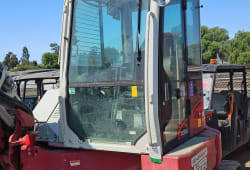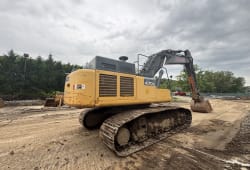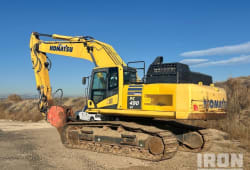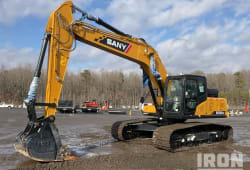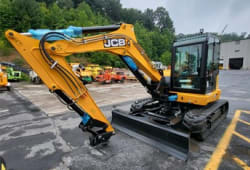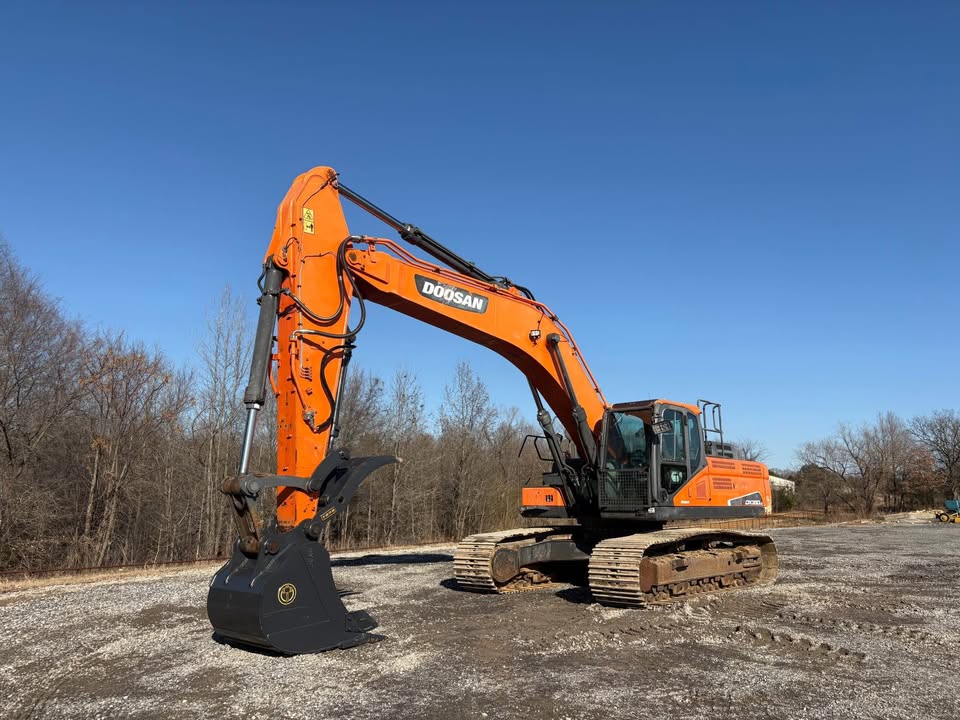Digging into Precision and Productivity with Excavators
9 Min read
)
September 9, 2023
In the world of heavy machinery, excavators stand as formidable workhorses, their precision and productivity second to none. But what fuels their impressive feats? This article delves into the core of these mechanical giants, unravelling the engineering secrets that make them tick. From the intricacies of their powerful arms to the cutting-edge technology guiding their every move, we uncover the evolution of excavators and their pivotal role in modern construction. Unmatched in their precision and productivity, these machines are more than tools; they're engineering marvels. Join us on a journey through the world of excavators and unearth their captivating story.
:format(webp))
The Anatomy of Excavators
Excavators, often referred to as "diggers," are engineering marvels designed for precision and productivity. To appreciate these machines fully, it's essential to delve into their anatomy, exploring the mechanical components that make up an excavator's powerful arms and hydraulic systems.
Hydraulic Systems: The Heart of an Excavator
At the core of every excavator lies a complex hydraulic system, which can be aptly described as the heart of the machine. This hydraulic system is responsible for the excavator's extraordinary power and precision, and it's the key to its ability to perform a wide range of popular types of job tasks.
This hydraulic system comprises several essential components:
- Hydraulic Pump: Think of equipment in this as the powerhouse of compact excavators. The hydraulic pump pressurizes hydraulic fluid, usually oil, to transmit power to various parts of the excavator. It's responsible for generating the force that drives the machine's movements.
- Cylinders: These are like the muscles of the excavator. Hydraulic cylinders are used as mini excavators to move different parts of the machine, including the arms, buckets, and boom booms. When hydraulic fluid is pumped into these cylinders, it creates a powerful force that enables precise movements of heavy equipment.
- Valves: Valves are like the control centre of the whole hydraulic excavator system. They regulate the flow of hydraulic fluid to different cylinders, allowing for precise control of the hydraulic excavator part of heavy equipment's functions. By adjusting the valves, operators can control the speed, direction, and force of various movements.
When you see an excavator's arm gracefully lifting massive loads of earthmoving dirt or precisely digging into the ground, it's the hydraulic system at work. It's this hydraulic system that enables the excavator to perform these jobs with incredible strength and precision, making it a versatile and indispensable machine in various industries.
Powerful Arms: The Muscle Behind the Machine
The arms of an excavator are its most defining feature, and they are the muscle behind the machine's impressive capabilities. These arms are what give the excavator its horsepower and the ability to dig deep into the earth or lift heavy objects with ease.
The arms of an excavator are not just a single rigid structure; they are highly articulated and consist of multiple joints. Each joint has its hydraulic cylinder, which provides the flexibility and strength required for various tasks. These joints allow the arms mid size of large excavators, to move in multiple directions, providing the excavator with a wide range of motion.
When it comes to excavation, trenching, or lifting tasks, the arms are the workhorses of the machine. They can be equipped and operated with many different types of attachments, such as buckets or grapples, to suit the specific job at hand. The hydraulic cylinders in the arms are precisely controlled by the operator, allowing for delicate movements when needed and powerful, forceful actions when required.
Evolution of Excavators
The history of excavators is a fascinating journey from simple prototypes to the sophisticated machines we have today.
Early Prototypes
The history of excavators takes us on a journey back in time to the earliest prototypes, which were rudimentary. These early machines represented the humble beginnings of what we now recognize as excavators.
Centuries ago, before the advent of modern machinery, the concept of excavation primarily relied on human or animal power. Labourers and animals were used to dig trenches, move the earth, and perform many other attachments of manual excavation tasks. These primitive methods, though labour-intensive and time-consuming, laid the foundation for the development of more advanced excavation machinery.
Mechanical Advancements
The real turning point in the evolution of hydraulic excavators came with the onset of the Industrial Revolution. This period marked a significant leap in excavation technology. Steam-powered machines were introduced, which brought about a revolution in the construction and mining industries.
Steam-powered excavators were a game-changer. They provided the power and efficiency needed to tackle large-scale projects. These machines could dig deeper, faster, and with greater precision than their human or animal-powered counterparts. The Industrial Revolution fueled advancements in excavation machinery, leading to the development of more sophisticated and powerful equipment.
Modern Marvels
Fast forward to today, and we find ourselves in awe of the modern excavators that are a testament to innovation and engineering excellence. These machines have come a long way from their humble beginnings.
Modern excavators are equipped with powerful engines that deliver impressive performance while being more energy-efficient. Precision control systems enable operators to carry out intricate tasks with ease, ensuring accurate digging and even soil grading. Cutting-edge materials make excavators more durable and capable of withstanding rigorous work environments.
Technology and Innovation
Advanced technology has played a pivotal role in enhancing excavator performance and thus operating efficiency.
GPS Systems: Precision Redefined
One of the most notable advancements in the world of excavators is the integration of GPS (Global Positioning System) technology-tracked excavators. This innovation has revolutionized how excavators operate by redefining precision and accuracy.
With GPS systems onboard, excavator operators can precisely navigate and control the machine with a level of accuracy previously unimaginable. These systems use satellite signals to pinpoint the excavator's exact location in real-time. This information is then integrated into the machine and operator's control system, allowing for pinpoint accuracy in digging and grading tasks.
In practical terms, this means that even in complex terrains, where precise measurements and angles are critical, excavators equipped with GPS can perform tasks with unmatched accuracy. For example, when excavating a foundation for a building, the excavator can follow digital plans with precision, ensuring that the foundation aligns perfectly with architectural specifications. This level of precision not only improves the quality of the largest excavator' work but also reduces material waste and costs and saves time.
Remote Operation: A Game-Changer
Another game-changing technological innovation is remote operation technology. This advancement has had a profound impact on the excavator rental industry by enhancing safety and expanding the range of environments in which these machines can be deployed.
Remote operation technology allows excavator operators to control the machine from a safe distance, often from a control room or even remotely through digital interfaces. This capability has significantly improved safety on construction sites, where hazardous conditions are common. Operators no longer need to be physically inside the excavator, reducing the risk of accidents and injuries.
The Excavator's Impact
The excavator's impact on modern construction and excavation job sites is undeniable. From mini excavators to wheeled excavators, these versatile machines come equipped with a wide array of excavator attachments that enable them to tackle a variety of tasks. Whether it's a Komatsu excavator with its impressive operating weight or mid-size excavators known for their flexibility, these machines offer unmatched efficiency. They can handle heavy-duty digging, and reach impressive dig depths, and even the biggest excavator can manoeuvre in tight spaces, making them indispensable on construction sites worldwide. The excavator's adaptability and power have revolutionized the construction industry, making it an essential tool for any excavation project.
Construction Projects
In the world of construction, excavators are like the backbone of the entire process. They serve as the workhorses that enable the construction of buildings, highways, and bridges. Their significance lies in their ability to perform a wide array of tasks critical for these projects. They can dig trenches, excavate foundations, and move vast amounts of earth efficiently. Whether it's preparing the ground for a skyscraper's foundation or creating the roadbed for a new highway, excavators are essential tools in the construction industry.
Mining Operations
Excavators play a pivotal role in mining operations, where precision and power are of paramount importance. Mining involves the extraction of valuable minerals and ores from the earth, and this task demands machinery that can handle heavy loads and navigate challenging terrains. Excavators fit this role perfectly, as they possess both immense power and precision. They are used to remove overburden, expose ore deposits, and load the extracted materials onto trucks for transportation. Without large excavators, mining operations would be far less efficient and safe.
Agriculture and Landscaping
Beyond construction and mining, excavators find applications in agriculture and landscaping. Their versatility makes them valuable tools for reshaping the land and transforming the natural environment. In agriculture, they can be used to create ponds, dig irrigation ditches, and clear fields, facilitating more efficient farming practices. In landscaping, excavators can shape gardens, dig trenches for utility lines, and remove trees and stumps. Their adaptability and precision enable these industries to achieve various tasks efficiently and with precision, ultimately enhancing productivity and aesthetics.
You May Read Used Excavators Under 20k for sale
Conclusion
Excavators are engineering marvels that have evolved over centuries. Understanding their intricate hydraulic systems, powerful arms, and the role of technology in their advancement is crucial to appreciating their significance. These machines are not just tools; they are the backbone of countless projects that shape our world. So, the next time you witness an excavator at work, take a moment to acknowledge the precision and productivity it brings to the table. Excavators are the unsung heroes of construction and excavation, deserving our admiration and respect.
Check Out the items available by the model no's
2017 John Deere 470G

Caleb Woods is an experienced content specialist and an editor at Boom & Bucket, blending his journalism background with expertise in the heavy equipment industry. He delivers engaging, informative content to help professionals stay informed and make smarter decisions in the machinery market.
